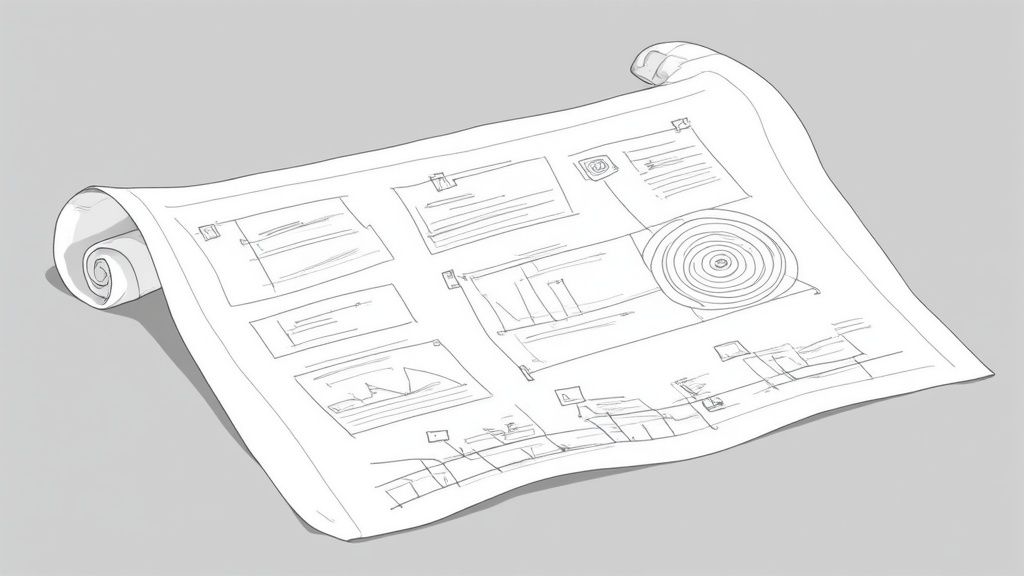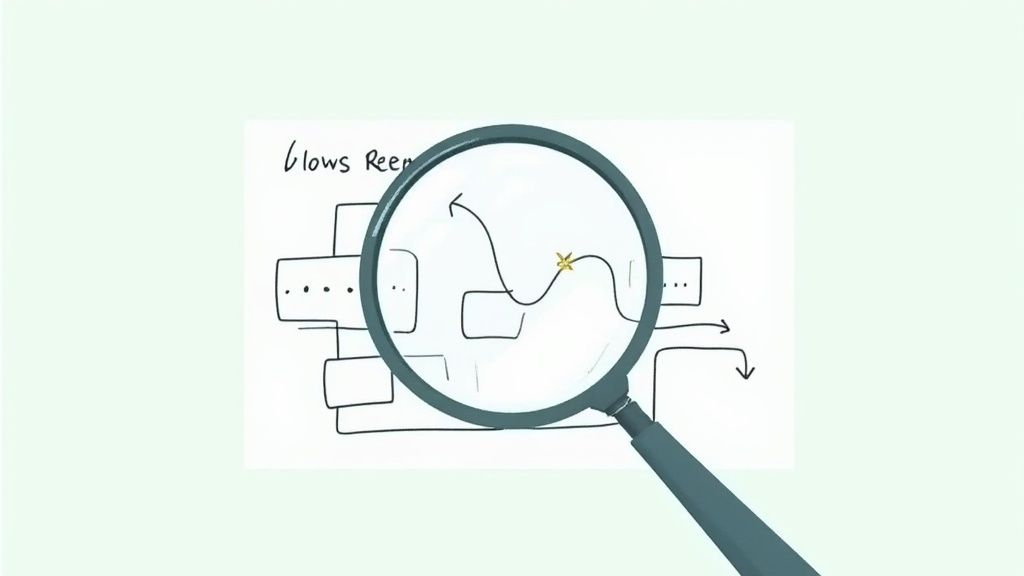Enterprise Resource Planning (ERP) systems act as the central nervous system for modern businesses, integrating core functions from finance and HR to supply chain management. The journey to a successful ERP implementation, however, is notoriously complex. While industry statistics often paint a grim picture of project failures, these outcomes are not a foregone conclusion. The critical difference between a transformative success and a costly disruption lies in a well-defined, strategic approach.
This guide moves beyond generic advice to deliver a comprehensive blueprint of the most essential ERP implementation best practices. Following these proven strategies will empower your organization to proactively mitigate common risks, maximize its return on investment, and ensure the new system directly supports long-term growth objectives.
We will provide actionable insights and practical steps for each phase of the process. Whether your organization is implementing a new system like Odoo for the first time or upgrading a decades-old legacy platform, this roundup offers the clarity needed for a seamless and successful transition. The goal is not just to go live but to unlock the full potential of your technology investment.
1. Comprehensive Project Planning and Scope Definition
The foundation of any successful ERP implementation lies in meticulous, upfront planning. This critical first step involves systematically defining the project’s objectives, scope, timelines, and resources before any technical work begins. A comprehensive plan acts as the project’s constitution, guiding every decision and ensuring all stakeholders are aligned on what the new system will and, just as importantly, will not accomplish.

Failing to establish a clear scope is a primary reason for ERP project failure, leading to scope creep, budget overruns, and missed deadlines. Conversely, organizations like Colgate-Palmolive successfully deployed SAP across 80 countries by adhering to a meticulous, phased plan that managed complexity and set clear expectations from the outset. This structured approach is one of the most vital erp implementation best practices.
How to Implement This Practice
Effective project planning is a collaborative effort, not a task for a single department. It requires input from across the organization to create a realistic and holistic roadmap.
- Establish a Governance Structure: Form a steering committee with executive sponsors and project managers early. This team will oversee the project, make key decisions, and resolve conflicts.
- Define ‘Done’ Clearly: Document specific, measurable, achievable, relevant, and time-bound (SMART) goals. For example, instead of “improve inventory management,” a better goal is “reduce inventory carrying costs by 15% within 12 months post-launch.”
- Document Everything: Use project management tools like Smartsheet or Microsoft Project to create a detailed project plan. This document should list all tasks, dependencies, timelines, resource assignments, assumptions, and constraints.
- Plan for Contingencies: Identify potential risks, such as data migration issues or key personnel changes, and develop contingency plans for each.
By investing heavily in the planning phase, you create a stable framework that minimizes surprises and maximizes your chances of a smooth, on-budget rollout. For a deeper understanding of the foundational elements, you can explore various resources covering ERP software fundamentals and planning.
2. Strong Executive Sponsorship and Leadership Commitment
An ERP implementation is more than a technology project; it is a fundamental business transformation. Therefore, its success hinges on unwavering support and active involvement from the highest levels of leadership. Strong executive sponsorship means having C-level champions who not only approve the budget but also actively drive the initiative, communicate its strategic value, and clear organizational hurdles.

Without this high-level commitment, projects often stall due to departmental resistance, resource conflicts, and a lack of clear direction. For instance, Ford Motor Company’s successful global ERP implementation was largely credited to its executive team’s visible sponsorship, which aligned disparate business units toward a common goal. This top-down reinforcement is one of the most critical erp implementation best practices because it signals the project’s importance to the entire organization.
How to Implement This Practice
Securing and maintaining executive commitment requires a strategic and continuous effort. It’s about keeping leaders informed, engaged, and empowered to steer the project effectively.
- Establish a Governance Cadence: Schedule regular, concise briefings with executive sponsors. Use scorecards or dashboards to report on progress, risks, and budget adherence, ensuring they have a clear view without getting lost in operational details.
- Define Clear Escalation Paths: Create a formal process for the project team to escalate critical issues that require executive intervention. This ensures that major roadblocks are addressed swiftly by those with the authority to resolve them.
- Link ERP Success to Executive KPIs: Tie the project’s key outcomes, such as cost savings or efficiency gains, directly to the performance metrics of the sponsoring executives. This creates a powerful incentive for their continued, active involvement.
- Ensure Sponsor Visibility: Involve sponsors in key project milestones, such as kickoff meetings, major go-live events, and company-wide communications. Their visible presence reinforces the project’s strategic priority.
By embedding leadership directly into the project’s fabric, you build resilience and momentum, ensuring the initiative can navigate the inevitable challenges of large-scale organizational change. The active championing from the top is often the deciding factor between a stalled project and a transformative success.
3. Thorough Business Process Analysis and Optimization
Specific Odoo ERP system is a powerful tool, but its true value is unlocked when it supports optimized business processes, not when it automates existing inefficiencies. This crucial step involves a deep-dive analysis of your current workflows to identify bottlenecks, redundancies, and opportunities for improvement. The goal is to redesign and standardize processes to align with industry best practices and the inherent logic of the new ERP system.

Simply paving over old cowpaths with new technology leads to disappointment and a poor return on investment. Instead, companies like Nestlé have demonstrated the power of this approach by standardizing business processes across 150 countries before their global SAP rollout, ensuring consistency and efficiency. This commitment to process reengineering is a cornerstone of effective erp implementation best practices and separates successful projects from failed ones.
How to Implement This Practice
Business process optimization requires a critical and collaborative examination of how work gets done today and how it should be done tomorrow. It is not just an IT task; it demands deep involvement from the people who execute the processes daily.
- Map Current and Future States: Use process mapping tools like Visio or Lucidchart to visually document your existing “as-is” workflows. Then, working with process owners, design the optimized “to-be” processes that leverage the ERP’s capabilities.
- Involve Process Owners and End-Users: The people closest to the work have the most valuable insights into its flaws and potential. Engage them in workshops to analyze, critique, and redesign end-to-end process flows, from procurement to payment.
- Benchmark Against Industry Standards: Research how top-performing companies in your industry handle key processes. Your ERP vendor and implementation partner can provide valuable templates and best-practice models built into the software.
- Prioritize and Document Changes: Focus on high-impact processes that will deliver the most significant benefits. Meticulously document all approved process changes and ensure they are incorporated into user training materials.
By treating the implementation as an opportunity for business transformation rather than just a technology upgrade, you lay the groundwork for realizing significant gains in productivity, data accuracy, and operational agility.
4. Comprehensive Change Management Strategy
An ERP system is only as good as the people who use it. A comprehensive change management strategy addresses the human side of the transition, focusing on helping employees understand, adapt to, and embrace new processes and technologies. It’s a structured approach that moves beyond simple training to foster genuine user adoption and minimize resistance, which is often the biggest hurdle to a successful go-live.

Neglecting this element can lead to low adoption rates, decreased productivity, and active resistance that sabotages the project’s ROI. In contrast, companies like Unilever have successfully navigated complex global ERP rollouts by investing heavily in change management tailored to diverse markets. Acknowledging the human factor is one of the most crucial erp implementation best practices for realizing the full value of the investment.
How to Implement This Practice
Effective change management is an ongoing process that should start on day one of the project, not as an afterthought before launch. It requires empathy, clear communication, and visible support from leadership.
- Start Early and Communicate Often: Begin change management activities during the planning phase. Use multiple channels like newsletters, town halls, and team meetings to explain the “why” behind the change, the benefits for the company, and what it means for individual roles.
- Appoint and Empower Change Champions: Identify influential employees from various departments to act as advocates for the new system. Train them first and empower them to provide peer support, gather feedback, and build momentum from within.
- Provide Role-Based, Tailored Training: Generic training is ineffective. Develop training programs specific to how each user role will interact with the new ERP. Hands-on, scenario-based sessions are far more effective than passive lectures.
- Establish Feedback Loops: Create clear channels for employees to ask questions, voice concerns, and provide feedback without fear of reprisal. Address this feedback promptly and transparently to build trust and show that their input is valued.
By systematically managing the people-centric aspects of the implementation, you can transform potential resistance into enthusiastic adoption. To see how expert guidance can shape this process, you can find out more about navigating complex digital transformations.
5. Phased Implementation Approach
Attempting to launch a full-scale ERP system across an entire organization at once, known as a “big bang” approach, is fraught with risk. A more strategic and risk-averse method is a phased implementation. This approach breaks down the enormous task of deployment into smaller, manageable stages, typically organized by business unit, geographical location, or system functionality. Each phase is a mini-project, allowing the team to learn, adapt, and build momentum.
This incremental rollout significantly reduces the operational shock and allows for course correction along the way. For instance, Chevron successfully managed its global ERP deployment using a phased approach, which allowed them to address regional complexities and apply lessons learned from early stages to subsequent rollouts. This controlled, iterative strategy is a cornerstone of modern erp implementation best practices, mitigating risk while building user confidence.
How to Implement This Practice
A successful phased implementation hinges on a well-defined sequence and clear criteria for moving from one stage to the next. It requires robust planning to ensure continuity and integration between the new system and legacy systems that remain active during the transition.
- Create Standardized Deployment Templates: Develop a repeatable “toolkit” or template for each phase. This should include standardized project plans, data migration scripts, training materials, and communication plans to ensure consistency and speed up subsequent rollouts.
- Establish Clear Go/No-Go Criteria: Before moving to the next phase, conduct a formal review. Define specific metrics and criteria that must be met, such as system stability, user adoption rates, or key performance indicators (KPIs), to greenlight the next stage.
- Start with Change-Ready Units: Begin the rollout with a business unit or location that is less operationally complex and more receptive to change. This creates an early win, provides a valuable learning experience, and builds a group of internal champions.
- Plan for Coexistence: During the transition, the new ERP and old systems will need to coexist. Plan for necessary integrations and data synchronization to ensure business operations continue smoothly without data silos or disruptions.
By adopting a phased approach, organizations can transform a daunting, high-stakes project into a series of calculated, successful steps, ensuring a more stable and sustainable long-term outcome.
6. Robust Data Migration and Quality Management
Your new ERP system is only as powerful as the data it contains. Robust data migration is the process of methodically extracting, cleaning, and transferring information from legacy systems to the new ERP. This isn’t a simple copy-paste operation; it’s a strategic initiative to ensure the data fueling your new system is accurate, consistent, and trustworthy from day one.
Neglecting data quality is a critical error, often leading to flawed reporting, poor decision-making, and user distrust in the new system. Companies like Starbucks, during their significant ERP transformation, understood this and prioritized the meticulous migration of customer and operational data to maintain a seamless customer experience. This focus on data integrity is one of the most crucial erp implementation best practices for achieving long-term ROI.
How to Implement This Practice
Effective data migration requires a dedicated sub-project with its own team, timeline, and quality standards. It should be treated with the same seriousness as the technical configuration of the ERP itself.
- Perform Data Profiling Early: Before moving anything, analyze your source data to identify inconsistencies, duplicates, and incomplete records. This initial assessment will define the scope of your data cleansing efforts.
- Establish Clear Data Governance: Assign ownership for data quality. Designate data stewards from each business department who are responsible for validating and approving the data relevant to their function, both during migration and post-launch.
- Use Automation Strategically: Leverage specialized data migration tools from vendors like Informatica or Talend. These tools can automate the complex Extract, Transform, Load (ETL) processes, reducing manual errors and accelerating the timeline.
- Conduct Multiple Test Runs: Never attempt a single, “big bang” migration at go-live. Perform several mock data migrations in a test environment to refine scripts, validate data, and time the process accurately for the final cutover.
- Create Data Quality Dashboards: Post-launch, implement dashboards to continuously monitor key data quality metrics. This helps maintain data hygiene and ensures the information within the ERP remains reliable over time.
7. Extensive Testing and Quality Assurance
Even the most well-planned ERP implementation can fail if the system is not thoroughly tested before go-live. A rigorous testing and quality assurance (QA) strategy is essential for validating every aspect of the new ERP, from core functionality and data integrity to performance under load. This phase is not a final check but an integral part of the development lifecycle, designed to identify and resolve defects before they impact business operations.
Neglecting testing is a high-risk gamble that can lead to system crashes, data corruption, and a complete loss of user confidence. Conversely, companies like Toyota implement comprehensive testing protocols for their global manufacturing ERPs to ensure every component functions flawlessly, from supply chain coordination to production scheduling. This commitment to quality assurance is a hallmark of successful erp implementation best practices.
How to Implement This Practice
Effective testing requires a multi-layered approach that involves different stakeholders, tools, and methodologies. It should begin early in the implementation cycle and continue through every stage.
- Develop Comprehensive Test Plans: Create detailed test scripts that cover all business processes, workflows, and integrations. These plans should outline the test objectives, steps, expected outcomes, and the data required for each scenario.
- Involve End-Users Directly: User Acceptance Testing (UAT) is crucial. Real users who will operate the system daily are best equipped to validate if it meets their needs and is intuitive to use. Their feedback is invaluable for identifying practical issues that technical teams might miss.
- Use Realistic Data and Scenarios: Test the system with data volumes and transaction types that mirror real-world, peak operational conditions. Testing with a small, clean dataset won’t reveal how the system will perform under pressure or with complex, legacy data.
- Establish Clear Defect Management: Implement a formal process for reporting, tracking, prioritizing, and resolving defects. Use a ticketing system to manage this workflow and ensure critical issues are addressed before launch.
8. Continuous Training and Support Strategy
An ERP system is only as good as the people who use it. A one-time training session before launch is insufficient for ensuring long-term adoption and proficiency. A continuous training and support strategy is essential for preparing users for the new system, helping them adapt to ongoing changes, and maximizing the return on your significant technology investment. This approach moves beyond a single event to a sustained program of learning and assistance.
Implementing a new ERP is a major change, and without proper, ongoing education, user frustration can lead to low adoption rates, incorrect data entry, and a failure to utilize the system’s full capabilities. Companies like Pfizer have demonstrated the power of this approach by implementing role-based training for their SAP rollouts, ensuring employees received relevant, practical knowledge. This commitment to user enablement is a cornerstone of effective erp implementation best practices.
How to Implement This Practice
A successful training strategy is dynamic, responsive, and tailored to the diverse needs of your workforce. It should be built into the project plan from the beginning, with resources allocated for post-launch support and continuous learning initiatives.
- Develop Role-Based, Scenario-Driven Training: Create training materials that mirror real business processes and scenarios for specific roles. Instead of generic feature overviews, show an accounts payable clerk how to process an invoice in the new system from start to finish.
- Establish a Super-User Network: Identify and train a group of power users or “super-users” within each department. These individuals act as the first line of support, offering peer-to-peer assistance and reducing the burden on the IT helpdesk.
- Create Accessible Support Resources: Develop a library of quick reference guides, job aids, and short video tutorials that users can access on demand. This allows employees to find answers to common questions without disrupting their workflow.
- Plan for Ongoing Education: The ERP system will evolve with updates and new modules. Schedule regular refresher courses and training sessions for new features to keep user skills sharp and ensure the organization continues to leverage the system effectively.
By investing in a robust and continuous training program, you empower your employees to become confident and competent users, driving system adoption and unlocking the full value of your ERP. As you plan your long-term support model, it’s also wise to stay informed about future IT support trends to keep your strategy current and effective. You can explore emerging IT support trends and their impact on business.
Best Practices Comparison of 8 ERP Implementation Factors
| Item | Implementation Complexity 🔄 | Resource Requirements ⚡ | Expected Outcomes 📊 | Ideal Use Cases 💡 | Key Advantages ⭐ |
|---|---|---|---|---|---|
| Comprehensive Project Planning and Scope Definition | High – requires detailed planning and stakeholder involvement | Significant upfront time and stakeholder engagement | Clear scope, risk mitigation, measurable success | Large-scale ERP projects needing strict scope control | Prevents scope creep; sets clear expectations |
| Strong Executive Sponsorship and Leadership Commitment | Moderate – needs executive time and engagement | Executive availability and ongoing leadership support | Adequate funding, faster decisions, better buy-in | Projects needing strong strategic alignment and change management | Accelerates decisions; ensures resource availability |
| Thorough Business Process Analysis and Optimization | High – involves deep analysis and process redesign | Cross-functional teams and business experts | Optimized processes, reduced customizations | Organizations aiming process standardization and efficiency improvements | Eliminates inefficiencies; maximizes ERP benefits |
| Comprehensive Change Management Strategy | Moderate to High – continuous throughout lifecycle | Dedicated change management resources and budget | Higher user adoption, reduced resistance | Projects with significant organizational change | Increases adoption; improves morale and engagement |
| Phased Implementation Approach | Moderate – requires phase planning and coordination | Staged resource allocation, pilot/test teams | Reduced risk, early value, iterative improvements | Complex, global, or multi-unit ERP deployments | Enables risk control; facilitates learning |
| Robust Data Migration and Quality Management | High – technically complex and resource intensive | Data specialists, validation tools | Accurate data, compliance, reliable reporting | Migrations from legacy systems with critical data needs | Ensures data integrity; reduces post go-live issues |
| Extensive Testing and Quality Assurance | High – multi-phase, requires skilled testers | Testing teams, automated tools | Stable, reliable system meeting requirements | ERP implementations requiring high assurance and reliability | Identifies issues early; improves user confidence |
| Continuous Training and Support Strategy | Moderate – ongoing training and support required | Training resources, multi-method delivery | High user proficiency and support | Organizations needing sustained user engagement | Maximizes adoption; reduces support calls |
From Planning to Performance: Your Next Steps
Navigating an ERP implementation is far more than a technical upgrade; it’s a fundamental business transformation. As we’ve explored, success hinges not on the software alone, but on the strategic framework you build around it. The ERP implementation best practices detailed in this guide, from initial planning to post-launch support, are not just suggestions. They are the essential pillars that prevent costly failures and ensure your investment delivers tangible, long-term value.
By embracing these principles, you shift the narrative from “installing software” to “enabling strategic growth.” You are building a resilient operational backbone designed to scale with your ambitions, provide clear business intelligence, and empower your teams to work more effectively.
Recapping the Core Pillars of Success
The journey from your current state to a fully optimized ERP environment is complex, but manageable when broken down into key focus areas. Remember the critical takeaways from our discussion:
- Strategic Foundation: Success starts long before the first line of code is written. Strong executive sponsorship provides the vision and authority, while comprehensive project planning creates the roadmap. Skipping these initial steps is the fastest route to budget overruns and misaligned objectives.
- Process and People Centricity: Your ERP is only as good as the processes it supports and the people who use it. Thorough business process analysis ensures you’re not just automating inefficiency. A robust change management strategy and continuous training are vital for user adoption and turning resistance into advocacy.
- Technical Excellence: The technical execution must be flawless. A phased implementation approach minimizes risk and allows for iterative learning. Likewise, a meticulous strategy for data migration and extensive testing ensures the system is reliable, accurate, and ready for real-world demands from day one.
Turning Best Practices into Business Reality
The true power of these concepts is realized when they are integrated into a cohesive strategy. An effective ERP implementation creates a domino effect of positive outcomes. Streamlined processes reduce operational friction, accurate data fuels better decision-making, and empowered employees drive innovation. This isn’t just about improving efficiency; it’s about building a more agile, resilient, and competitive organization.
Your next step is to move from understanding these best practices to actively applying them. Begin by assessing your organization’s readiness against each of the eight pillars. Where are your strengths? Where are the potential gaps that need reinforcement? Use this framework as a checklist to guide your internal discussions and vendor evaluations. An ERP project guided by these proven principles is an investment that will pay dividends for years to come, solidifying your operational foundation and freeing you to focus on future growth.
Ready to transform your business operations with a seamlessly integrated ERP system? The experts at KP Infotech specialize in implementing these best practices, delivering customized Odoo solutions that align perfectly with your strategic goals. Contact us today to learn how our strategic guidance and end-to-end project management can ensure your ERP implementation is a resounding success. KP Infotech
